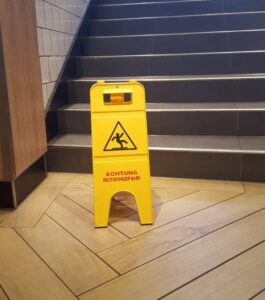Safety days, safety courses, poster campaigns or even a theater stage in the canteen. Companies use a wide repertoire of instruments when it comes to persuading employees to follow occupational safety rules. In fact, in many workplaces, organizational and technological means are considered largely exhausted. Today, the focus is widely on the challenge of using preventive offerings to influence the safety-related behavior of employees. However, this is proving to be a tough nut to crack. After all, occupational safety is about observing rules and learning how to behave, and thus about goals that do not necessarily meet with pleasurable feedback from most people.
So where do you start to motivate people to learn new things, see things differently, and ultimately behave differently? It is clear, after all, that communication plays a key role in this. We wanted to find out more and asked neuroscientist and brain researcher Henning Beck to explain how our brain actually deals with communication offers on the subject of occupational safety.
Dr. Beck, how quickly does a message become permanently anchored in the brain? Or to put it another way: Is it a question of the duration of a communication offer, for example a campaign, in order to sustainably increase awareness of the topic?
The brain can permanently store some things after just one time. The prerequisite for this is: it has to be new and different and emotionally exciting, preferably with a positive feeling. Such an “aha” moment can then give the starting signal for a lasting rethinking of one’s behavior. This starting impulse can then be effectively kept going with small measures.
How important is variety in communication to achieve lasting interest?
There are two basic rules for successful communication: It should be varied and personal. The more varied the exchange of information, the better the message will stick. So it’s best to use different media, pictures, texts, films – and personal exchanges. Because for the brain, there is nothing more exciting than being with other people. The personal conversation, the human contact is still the best method to generate interest and to anchor a message permanently.
So how should a good campaign for occupational safety be structured?
For one thing, it relies on strong images that employees can identify with. Our brain absorbs important information best when it takes place in good stories. Good stories, that is often a lot of words to read. However, as we all know, a picture is worth a thousand words and can also be grasped quickly.
Second, the campaign should create a sense of “we” that helps messages stick in people’s minds. After all, the brain only really blossoms in community. By addressing all employees, the individual feels part of a community. He or she gets the feeling that the occupational health and safety guidelines are not only applicable to him or her, but also to others.
Can important topics such as occupational safety be communicated via game-based learning – today there is also talk of “serious games”? Is information learned in this way actually better stored by the brain?
In games, we can try things out without danger and thus learn in a much more informal way. Play creates a safe place where we dare to do more and thus reduce typical inhibitions to learning: Play motivates and is often characterized by a strong personal exchange. This helps us to understand new actions quickly. To be sure, games alone are not enough to learn things comprehensively. But they offer a great and varied supplement to the usual training and learning program.
Let’s talk about routine in the workplace. Is it more of a friend or foe of occupational safety?
Both. From a neurobiological point of view, routines are shortcuts that the brain builds in order to perform learned and internalized processes with less effort. As a trained driver, for example, we no longer have to concentrate on shifting gears and steering. In a sense, we drive automatically. This makes it less of an effort for us.
On the one hand, this is good, but on the other hand it also involves risks, because we then don’t always pay the necessary attention. An example of this would be the drive home from work. If, while parking, you wonder how you got here at all, you drove home routinely, but thus also absent-mindedly – and thus unsafely.
How can you counteract inattention?
It is sufficient to pause briefly before beginning a familiar action and to make oneself aware that a new routine situation is now beginning. Be it before putting on the work clothes or before the first hand movement on or with the work equipment. When we knowingly enter into a routine, attention is maintained, but the risk of accidents decreases.
About our expert:

Henning Beck was born in 1983 on the Bergstrasse in southern Hesse and studied biochemistry in Tübingen. After receiving his diploma, he earned his doctorate at the Graduate School of Cellular & Molecular Neuroscience there. He worked at the University of California at Berkeley, publishes regularly in Wirtschaftswoche and GEO magazine, and gives lectures and workshops on topics such as “Neurobiology and Creativity”. Henning Beck lives in Frankfurt and works at the Scene Grammar Lab there. In February 2017, Hanser published his latest book, “Irren ist nützlich” (“To err is useful”), in which he shows why it is the brain’s thinking errors that ultimately get us ahead.
You can dive deeper into our understanding on our Occupational Safety and Health topic page on the blog.


